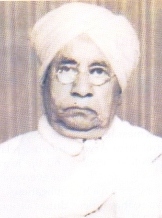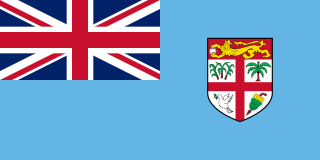
Charles Freer Andrews was a Church of England priest. A Christian missionary, educator and social reformer in India, he became a close friend of Mahatma Gandhi and identified with the cause of India's independence. He was instrumental in convincing Gandhi to return to India from South Africa, where Gandhi had been a leading light in the Indian civil rights struggle.
Badri Maharaj was an Indo-Fijian farmer, politician, and philanthropist. He was the first Indian member of the Legislative Council serving for two periods between 1916 and 1923 and 1926 to 1929 as a nominated member but he was not a popular choice for Fiji Indians, who preferred the lawyer, Manilal Doctor to be their representative. Despite his unpopularity, he was a man of principle and resigned from the Council in protest at what he believed was an unfair imposition of poll tax on the Fiji Indian people. He proposed an innovative system of Indian administration (panchayat) and showed himself to be ahead of his time by opposing child marriage and promoting education.
Sadhu Vashist Muni was a Hindu missionary from India, who came into prominence in Fiji when he assumed the leadership of the strike in the western districts of Fiji in 1921. Mystery surrounded him during his short stay in Fiji and tales of his miraculous deeds still circulate in Fiji. The Government could not find out much about him from its sources of intelligence but deported him in the belief that he was an agent of Gandhi. After his arrest, the Government House in Suva was struck by lightning and destroyed which only heightened the belief in the power this mysterious sadhu.

The Muslims of Fiji comprise approximately 7% of the population (62,534). The Muslim community is made up of people of Indian origin, descendants of indentured labourers who were brought to the islands in the late 19th century by the British colonialist rulers of the time. There are also thought to be a few hundred Indigenous Fijian Muslims, such as the well-known politician Apisai Tora, but no accurate statistical data exist in this regard.
Unlike the bulk of Fiji's Indian population, who are descendents of Indian indentured labourers brought to Fiji between 1879 and 1916, the Gujaratis came to Fiji as free immigrants beginning in 1904. While the indentured labourers, on becoming free, generally took up farming, the Gujaratis were traders and craftsmen. In the Indo-Fijian population as a whole, the caste system disappeared within a few years of indenture, but the Gujaratis still maintain it and very rarely marry outside their caste. The Gujaratis continue to maintain strong links with India, usually sending their sons and daughters to be married there while the rest of Fiji's Indian population have little contact with their country of origin.

Thakur Kundan Pal Singh Kush (1881–1967) was an Arya Samaj missionary and teacher who arrived in Fiji, from Muzaffarnagar, Uttar Pradesh, India in 1928. He first taught at the Dharamshala School in Nausori where he later became the founding Head Teacher of Vunimono Arya School in 1929. He taught in a number of Arya Samaj schools which included Gurukul Primary School near Lautoka in 1939, Arya Samaj Girls' School in Saweni, Lautoka, from 1940 to 1945, Swami Shraddanand Memorial School in Suva, Vunikavikaloa Arya School in Ra, and Veisari Primary School near Suva.
The Indian Reform League was formed in Fiji in 1924, following the refusal of the Suva Y.M.C.A. to admit Indians. Its founder was A.W. McMillan of the New Zealand Y.M.C.A and educated Indians and Government clerks and interpreters such as M. S. Buksh, S. S. Chowla, John F. Grant, Ilahi Ramzan, and Ram Narayan Deoki. Its aim was to carry out social work and apply pressure for social reform, like changes to marriage laws. Since most of its members were Indian Christians, it soon acquired a sectional character.

The Arya Pratinidhi Sabha of Fiji is the national body for all the Arya Samajs in Fiji. It was formed in 1918 and registered as a religious body through the efforts of Manilal Doctor, who was in Fiji from 1912 to 1920 at the behest of Mahatma Gandhi to provide legal assistance to the Fiji Indians. Its first President was Swami Manoharanand Saraswati who had arrived in Fiji, from India, in 1913. The Arya Pratinidhi Sabha of Fiji is affiliated to Sarvadeshik Arya Pratinidhi Sabha based in New Delhi.
Unlike the majority of Fiji's Indian population, who are descendants of Indian indentured labourers brought to Fiji between 1879 and 1916, most of the Sikhs came to Fiji as free immigrants. Most Sikhs established themselves as farmers. Sikhs also came to Fiji as policemen, teachers and preachers. In recent years large numbers of Sikhs have emigrated from Fiji, especially to the United States, Canada, the United Kingdom, Australia and New Zealand. Sikhs in Fiji are generally referred to as Punjabis.
Hindu Maha Sabha was an organisation representing various Hindu organisations and was formed in Fiji in 1926, following the formation of All-India Hindu Maha Sabha in India. The formation of the organisation both in India and Fiji occurred after the assassination of Swami Shraddhanand, a Hindu activist in India. The formation of the Sabha in Fiji coincided with the formation of a national Muslim organisation, the Fiji Muslim League.
This is a synopsis of organisations formed by Indians in Fiji. When they became free from the bondage of indenture and were able to organise themselves, they founded numerous organizations to seek social and political justice. These organisations promoted the teaching of Indian languages and religious practices and also to helped others in time of need. Some of the successful organisations are listed below in order in which they were established. Some, such as the National Federation Party, are no longer exclusively Indian, but are still predominantly so.
Indian Association of Fiji has been the name used by organisations formed at different times in the history of Fiji, to unite different groups within the Fiji Indian community to work to improve the plight of Indians in Fiji.
Indo-Fijians or Indian-Fijians, are Fiji citizens who are fully or partially of Indian descent, which includes descendants who trace their heritage from various regions of the Indian subcontinent. Although Indo-Fijians constituted a majority of the Fijian population from 1956 through the late 1980s, discrimination and the resulting brain drain has resulted in them numbering 313,798 (37.6%) out of a total of 827,900 people living in Fiji today.







